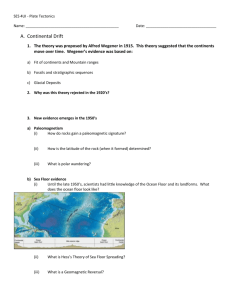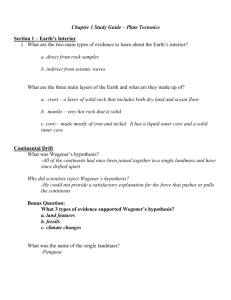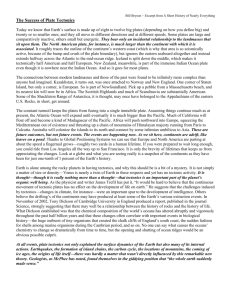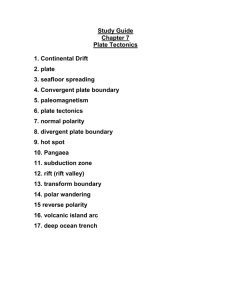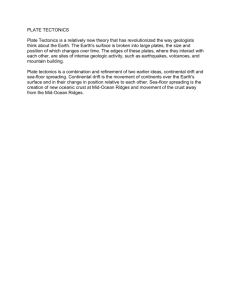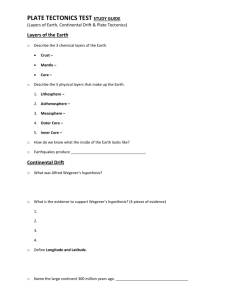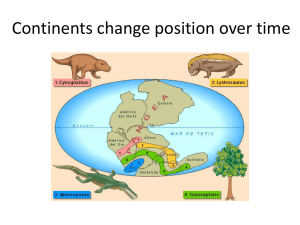full article
advertisement
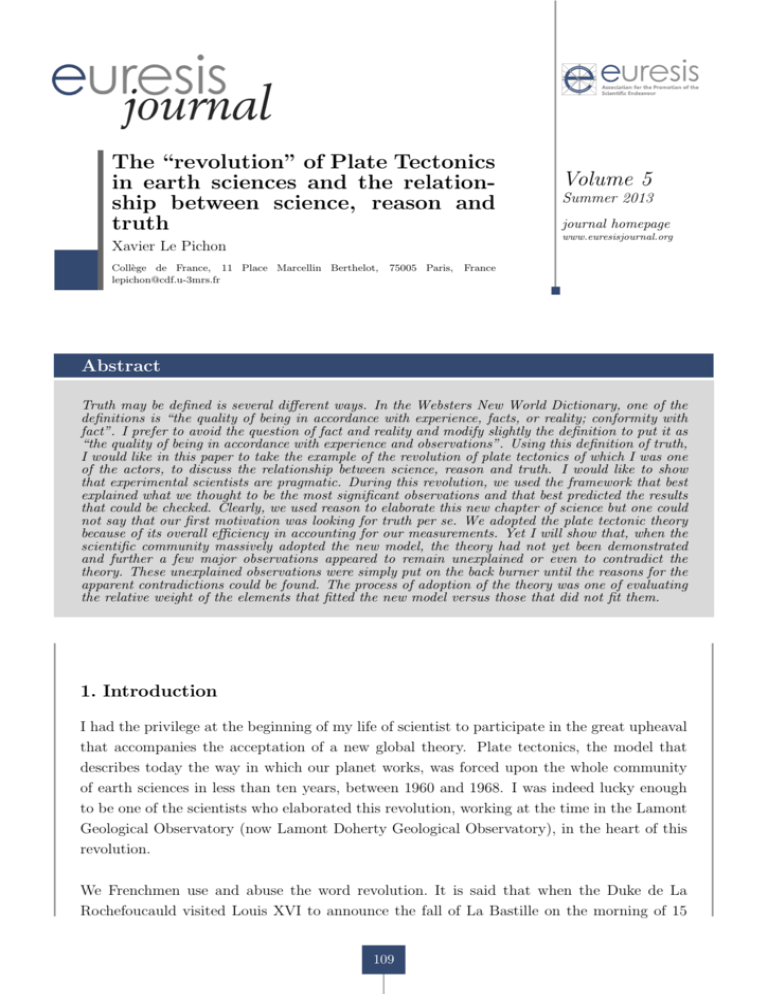
The “revolution” of Plate Tectonics in earth sciences and the relationship between science, reason and truth Xavier Le Pichon Collège de France, 11 Place Marcellin Berthelot, lepichon@cdf.u-3mrs.fr 75005 Paris, Volume 5 Summer 2013 journal homepage www.euresisjournal.org France Abstract Truth may be defined is several di↵erent ways. In the Websters New World Dictionary, one of the definitions is “the quality of being in accordance with experience, facts, or reality; conformity with fact”. I prefer to avoid the question of fact and reality and modify slightly the definition to put it as “the quality of being in accordance with experience and observations”. Using this definition of truth, I would like in this paper to take the example of the revolution of plate tectonics of which I was one of the actors, to discuss the relationship between science, reason and truth. I would like to show that experimental scientists are pragmatic. During this revolution, we used the framework that best explained what we thought to be the most significant observations and that best predicted the results that could be checked. Clearly, we used reason to elaborate this new chapter of science but one could not say that our first motivation was looking for truth per se. We adopted the plate tectonic theory because of its overall efficiency in accounting for our measurements. Yet I will show that, when the scientific community massively adopted the new model, the theory had not yet been demonstrated and further a few major observations appeared to remain unexplained or even to contradict the theory. These unexplained observations were simply put on the back burner until the reasons for the apparent contradictions could be found. The process of adoption of the theory was one of evaluating the relative weight of the elements that fitted the new model versus those that did not fit them. 1. Introduction I had the privilege at the beginning of my life of scientist to participate in the great upheaval that accompanies the acceptation of a new global theory. Plate tectonics, the model that describes today the way in which our planet works, was forced upon the whole community of earth sciences in less than ten years, between 1960 and 1968. I was indeed lucky enough to be one of the scientists who elaborated this revolution, working at the time in the Lamont Geological Observatory (now Lamont Doherty Geological Observatory), in the heart of this revolution. We Frenchmen use and abuse the word revolution. It is said that when the Duke de La Rochefoucauld visited Louis XVI to announce the fall of La Bastille on the morning of 15 109 Volume 5 The revolution of Plate Tectonics Summer 2013 July 1789, the king asked him: “Is it a revolt?” and La Rochefoucauld answered: “Majesty, this is not a revolt, it is a revolution.” It was not obvious at the time to make this distinction. Indeed, at the time, France was not a↵ected by one of these frequent revolts. It had entered a revolution that will permanently reshape not only its future, but the future of humanity. Revolt or revolution? This is also a major and most difficult question that faces the scientists when they have to evaluate the proposal of a new paradigm (paradigm here is understood in the sense of model as in [1]). How does one know whether the upheaval we are going through in science is an ephemeral revolt or a revolution that will definitively change the way our science is conducted? And what are the reasons for which this new theory is forced upon the whole scientific community in a permanent way? These will be my guiding questions throughout this short essay. Note that my aim here is not to present exhaustively the history of the revolution of plate tectonics but to discern the way in which the scientific community went through this period based on my own experience. The reader interested in the history might want to consult several articles that give my vision of this extraordinary period of my life [2, 3, 4, 5]. 2. Why continental drift was not a revolution? Earth is one of the archetypes most deeply anchored in our subconscious. Nurturing mother, center of our universe, the Earth was always assumed to be permanent and stable. Thus volcanism and seismicity aroused the deepest fears in humans because they originate in the very entrails of their nurturing mother. The heliocentrism proposed by the Copernican revolution was inevitably and deeply traumatic, with Galileo its most famous victim. As Tuzo Wilson noted in 1970 [6], the earth sciences revolution that we have just lived and which led us to accept that the Earth is neither stable nor permanent was the prolongation of the Copernican revolution. With the plate tectonic model we now know that the Earth is a living planet, whose configuration continuously changes as a result of the horizontal displacement of thousands of kilometers of crust in a geologically short time. Of course, geologists had noted quite early that vertical motions had brought marine sediments to the tops of the highest mountains. But they implicitly assumed that any two adjacent regions had always been so in the past. Fixism was the dominating paradigm until 1968. The Austrian, Edward Suess, in his major synthesis at the beginning of the century [7] described the Earth as a cooling planet whose contracting surface was slowly cracked and crumpled. It was in 1912 that Alfred Wegener proposed the first mobilist theory [8], with the drift of continental rafts. The continents would plow through the ocean floor, generating mountain belts on their bows and disseminating small pieces as island arcs behind their sterns. Continents would consequently be the active elements in a continuous regeneration of the configuration of the Earth. Vertical motions of the order of a few kilometers would thus be the result of horizontal motions of thousands of kilometers. 110 Volume 5 The revolution of Plate Tectonics Summer 2013 Thus, Wegener’s continental drift hypothesis centered on the continents and their geological history. His model was proposed for purely geological reasons. As stated by Harold Je↵reys in 1924 the continental drift theory is an “explanation, which explains nothing that we (geophysicists) want to explain” [9], The only geophysical proof proposed by Wegener was the apparent astronomical longitude change of Greenland, which was later shown to be the result of measurement errors. Furthermore, the mechanism he proposed for the displacements of the continents, plowing through the ocean floor, could explain neither the present distribution of volcanoes, nor the distribution of earthquakes. Finally, the concept was obviously mechanically impossible. Wegener’s intuitions on the mobility of continents and their deformation had operating value only in the paleogeographic domain of continental reconstructions. Wegener’s attempts at a global tectonic explanation included the assumption that continental blocks are mechanical resistant whereas the ocean floors are fluid and easily deformable. He assumed that the continents were made of rigid and brittle granite, the Sial (for silicates of alumine) on top of ductile Sima (for silicates of magnesium) that could be stretched and easily deformed like marsh-mallow. But Je↵reys rightly objected: It appears, in fact, that Wegener, having assumed a finite viscosity for the Sima below the continents, where it would be at a high temperature (which is a reasonable assumption), light-heartedly did the same for it on the ocean floor, where the temperature is about 0 C. The ocean floor shows irregularities of level of the same order of magnitude as those within the continents, and must have a comparable strength to prevent them from flattening out. This very simple objection invalidated the model proposed by Wegener. It was not until the 1950s that the study of the fossil magnetic field produced the first solid independent evidence of the displacements of the continents, thus restoring some scientific respectability to Wegener’s proposal that the continents drifted but not to the mechanism he proposed. In the meantime the earth science community, after intense debate in the 1920s, had rejected the continental drift theory as a foreign body dangerous to its harmonious growth. Fifty-six years had to go by before the existence of the geologically rapid formation of the ocean floor at the axes of mid-ocean ridges was established, a formation that results in continental drift. In this new mobilist model the continents are no longer the active elements. On the contrary they are passively transported within large plates some one hundred km thick, which are generated as they part at the axes of the oceans, and then disappear along the deep trenches of the active ocean margins. But the most interesting point made by Je↵reys is actually the heart of this essay. What are the conditions necessary to move from the old paradigm to the new one? Je↵reys stated: “I must reject the whole attitude that maintains that any type of scientific evidence can by itself be so completely demonstrative as to require rejection of any evidence that appears to conflict with it. If evidence is conflicting, the scientific attitude is to look for a new idea that may reconciliate.” We will see that the scientific community did not behave in this way when adopting the new mobilist paradigm. It actually adopted it much before all conflicts with 111 Volume 5 The revolution of Plate Tectonics Summer 2013 evidence had been explained away as these conflicts were progressively resolved quite a few years later. Actually plate tectonics became the new Earth model sometime in 1967-1968, fifteen years before it was definitely demonstrated in the 1980s by the geodetic measurements of motions of the plates that Wegener had erroneously believed to have already obtained in 1929! That mobilism was rejected for so long is conventionally ascribed to the psychological or sociological weaknesses of the scientific community. It is true that the psychological context makes the passage from one paradigm to the other more or less difficult. This passage may produce deep traumas. But the way in which I have lived the Earth science revolution suggests to me that the passage from one system to the other is made on purely rational bases that are independent of the size of the related traumas. This passage occurs whenever the explicative and predictive power of the new paradigm is superior to the power of the old one for the totality of the observations made by scientists. The type of mobilism proposed by Wegener had led the community into a dead end. It is the exploration of the ocean floor that opened the way for a new mobilist model: plate tectonics. 3. A Revolution brought by the exploration of the ocean floor Earth sciences until the Second World War had actually been continents sciences as the great majority of the observations came from the continents. The congenital flaw of continental drift came from the erroneous vision that Wegener had of the structure of the ocean floor. As stated by Tuzo Wilson “It is when the geologist decided to look overboard that he realized that his boat (the continent) was moving.” The Second World War had given a decisive impulsion to the exploration of the oceans. The US navy had recruited numbers of oceanographers to contribute to submarine warfare research. After the war, they kept their relations with the navy that financed their research. It was the beginning of the systematic exploration of the oceans that used numerous tools conceived for submarine warfare. The revolution of ideas that led to plate tectonics was principally due to the continuous interaction between scientists of three laboratories, Lamont and Princeton in the United States, and Cambridge University in England. Each of these laboratories was dominated by a strong personality: Maurice Ewing at Lamont, Harry Hess at Princeton, and Edward (Teddy) Bullard at Cambridge. Although having quite di↵erent origins and intellectual capacities, they had in common a deep interest in the geology of the oceans. It was Richard Field, a professor at Princeton, who had communicated this interest to them during the thirties. Field was convinced that one could not understand anything about the Earth as long as one only studied the small portion above sea level. “With the burning zeal of a Biblical prophet” as Bullard put it, he converted them to his faith. It is without doubt Maurice Ewing who acquired the most burning zeal for the exploration 112 Volume 5 The revolution of Plate Tectonics Summer 2013 of the oceans. With him, marine geology entered a new era. From the scattered approach based on discontinuous point measurements, Ewing moved to a global approach based on continuous measurements. He was the first to deliberately install himself within the oceanic world, inventing ad hoc the tools he needed to obtain the maximum amount of new data on every kind of subject. Although he was a theoretician, he was not comfortable with speculation. He made a religion of data acquisition. When I arrived at Lamont in 1959, with a Fulbright Fellowship to study oceanography, Doc, as he was known by his students, sent me around the world on his three-master, the R/V VEMA. “Oceanography has to be learned at sea”, he told me. Teddy Bullard, when asking Doc where he kept his ships, was answered: “At sea”. His deep interest in the exploration of virgin territories probably came from his northern Texas origins. He loved to be where nobody else was. When I told him in 1968 that I had decided to go back to France, he asked me how I could return to such an old country. “If I had to start a new life today, I would go to Australia”. Actually, when he did move, he went back home to Texas. But, if Texas was always close to his heart, the ocean remained to the end his real Far West. To the end of his life he still did not accept that plate tectonics had succeeded in revealing the secrets of his ocean. Shortly before his death in 1974, he confided to me that each time his ship came back he was waiting for the new evidence that would show that the whole plate tectonic model was wrong: the ocean could not be that simple. In any case, in 1959 the big thing at Lamont was the discovery of the Rift Valley that runs along the crests of mid-ocean ridges. Earthquakes and volcanic eruptions characterize the whole length of the Rift. VEMA cruise 16, in which I was going to participate, was supposed to test the continuity of the Rift Valley from the Atlantic Ocean to the Indian Ocean. Maurice Ewing and one of his students Bruce Heezen had predicted in 1956 the continuity of the Rift Valley through the oceans, along the mid-ocean seismic belt, which had been described in 1954 by a Frenchman from Strasbourg, Jean-Pierre Roth (1954). We were going to zigzag for nine months above this famous seismic line to test the prediction. As it was estimated to be sixty thousand km long, the almost unknown Rift Valley suddenly became the most important structure on Earth! It became clear then that no model of the evolution of the Earth ignoring the Rift could be considered valid. This fundamental discovery made by the Ewing team followed another by the same team. Seismological observations had actually established what had been inferred from gravity measurements: the uplift of the crust-mantle interface (the MOHO) to a depth of ten to five km under the ocean floor. Under the continents, the MOHO lies at a depth of about thirty km. Thus, oceanic crust is on average four times less thick than continental crust. It was concluded that both crusts were distinct types, with probably di↵erent origins and evolutions. But perhaps even more importantly, the thickness of the sediments in the ocean basins appeared to be very small. In the fixist model, the ocean floor should have about 113 Volume 5 The revolution of Plate Tectonics Summer 2013 the same age as the adjacent continents. The average age of the continents is 3.8 billion years (compared to 4.55 billion years for the age of the Earth). One expected then to find in the ocean basins huge thicknesses formed by the erosion of the continents. Yet seismological observations clearly indicated that this was not so. From then on, the whole debate on the dynamics of the Earth would be concerned, first, with the significance of this radical di↵erence of structure and apparent age between oceans and continents and, second, with the significance, within the oceans, of the Rift Valley. The oceans thus became the heart of the Earth debate. At Lamont, two schools of thought prevailed. To Bruce Heezen, the young geologist who had just finished his thesis, under the direction of Ewing, on the morphology of the northern Atlantic Ocean, everything could simply be explained if one accepted the ideas proposed by S.W. Carey of the University of Hobart in Tasmania in 1958 concerning the rapid expansion of the Earth [10]. Oceans were geologically recent structures formed by expansion from the Rift. Heezen was consequently a mobilist. But Maurice Ewing rightly thought that the idea of such a fast expansion (a 75 percent increase in the Earth’s radius in a hundred million years) was physically absurd. He remained a fixist and preferred to explain the tectonic activity of the Rift by borrowing to a British geologist Arthur Holmes the concept of deep convection currents, in the mantle below the Rift, which did not reach the surface but were the cause of its extension and volcanism. Thus, already at this time, a combination of the ideas of Heezen and Ewing would have led directly to the hypothesis of Sea Floor Spreading. But for Ewing such speculations were premature. What did they bring to science? New facts were within reach of our dredges, corers, cameras, magnetometers. With his younger brother John Ewing he was inventing marine seismic reflection, a technique to continuously record the thickness of the sedimentary cover. This technique was going to confirm that the ocean sediment cover is very thin and is totally absent near the Rift. Yet, during this whole time, the Lamont team was far from monolithic, contrary to what has often been stated since. There were two schools. One, which was more geologically inclined and included the students of Heezen, was mobilist and expansionist. The other, which was more geophysically inclined, and to which I belonged, was fixist and believed in longstanding ocean-continent distribution. And, if Lamont faction leaders could hardly work with each other, the younger scientists had many vivid exchanges, especially when they were at sea. The debate was open and always stayed open; this was not the case in most other laboratories, which, at least in the United States, were massively and often aggressively fixist. 4. Princeton and the seafloor-spreading Hypothesis In 1957, Heezen presented during a seminar at Princeton his ideas about the expansion of the oceans from the Rift. Harry Hess was one of his attentive listeners. He stated after 114 Volume 5 The revolution of Plate Tectonics Summer 2013 the seminar “You have shaken the foundation of geology.” Hess, through a rather complex chain of reasoning, had become convinced that the oceanic crust is not chemically di↵erentiated from the mantle, but consists of serpentine, a hydrated peridotite. Thus the mantle would nearly outcrop on the ocean floor. Hess had also become convinced, following Vening Meinesz, that ocean trenches were convergence zones where the floor of the oceans is thrust under the adjacent continents. Combining these hypotheses with the Rift expansion concept, Hess brought the convection currents of Arthur Holmes and Maurice Ewing to the seafloor, introducing the idea of the conveyor-belt. Thus the upper mantle would rise along the Rift where it would become hydrated; it would move undeformed from the Rift to the trenches, to plunge back into the deep Earth. His hypothesis took into account the radical di↵erence of structure between oceanic and continental crusts. It attributed the small thickness of oceanic sediments to the youth of the oceanic basins. The volcanic and extensional tectonic activity at the Rift was explained by the divergence of the two conveyor belts. This model eliminated the difficulties of Wegener’s model, although it did account for continental drift which paleomagnetic studies rendered more probable every year. Yet it was originally based on one false hypothesis: we now know that the oceanic crust consists principally of basalt and not serpentine. Hess’ model, presented as a contract report, was widely circulated in 1960, including at Lamont, although it was not published until 1962 [11]. In between, in 1961, Robert Dietz proposed its now famous trade name of Sea Floor Spreading. Hess, with his usual openmindedness, presented his new ideas as a working hypothesis that should not be taken too seriously, an essay in geopoetry. His caution may also have been due to the aggressiveness of the fixist school in the U.S. Most of the senior geophysicists would then shoot at sight at the few mobilists trying to present their ideas at the American Geophysical Union meetings in Washington. With Sea Floor Spreading, the scientists finally disposed of a new coherent mobilist model that accounted both for the small age of the ocean floor and the existence of the mid-ocean Rift, two observations that appeared to discredit any fixist model. But to accept such a revolutionary change of paradigm, the scientific community needed a convincing test. Six years and one detour through Cambridge would be necessary to establish Sea Floor Spreading as the prevailing model. 5. Cambridge and the ”Vine and Matthews” test It was magnetism that provided the decisive test for the validity of Sea Floor Spreading. This test was proposed independently, in 1963, in Canada by Lawrence Morley, and at Cambridge by Fred Vine. Both had a good knowledge of the magnetization of rocks. Morley had actually studied paleomagnetism, and Vine had worked with paleomagneticists. At Cambridge 115 Volume 5 The revolution of Plate Tectonics Summer 2013 Bullard was well known for his interest in the Earth’s magnetic field and for paleomagnetic investigations. By this time, paleomagneticists had demonstrated the existence of inversions of polarity of the Earth’s magnetic field. Thus, for Morley and Vine, if there is seafloor spreading, the lavas which flow on the floor of the Rift Valley must be magnetized in the contemporaneous magnetic field, which is alternatively positive and negative. The floor of the oceans must then consist of magnetized stripes parallel to the Rift and having alternative polarities. Morley went farther than Vine, as he rightly concluded that the resulting magnetic anomalies should be symmetric with respect to the Rift. One should therefore be able to use them to measure the rate of seafloor spreading. There was at that time no existing survey of linear and symmetric magnetic anomalies clearly related to a properly identified ocean ridge crest. In the North Atlantic Ocean, where the Lamont teams had mostly worked, and in the northern Indian Ocean, where Vine and his instructor Drummond Matthews worked, the magnetic anomalies were highly irregular. Nice linear anomalies had been mapped by Ra↵ and Mason in 1961 o↵ the West United States coast, but no Rift was known there. Actually, the Rift along which these anomalies were formed had since disappeared within the oceanic trench, which had existed in earlier geological times along the North American western margin. As stated by Vine, at the time when the concept was proposed, few actual proofs of it could be advanced and, in a way, this concept created more problems than it solved. Vine’s paper [12], as well as Morley’s paper (rejected by Nature and the Journal of Geophysical Research in 1963 —probably because it contained no new data— and published with Larochelle as co-author in 1964), were completely ignored. I remember reading Vine and Matthews’ paper when it was published but, to my knowledge, the paper was not seriously debated among us. It is significant that neither Vine, nor Matthews, nor Morley, nor anybody else considered any follow-up to these two papers during the two following years. Once more, it was Harry Hess who was to open a new pass. Hess had already played a major role in the elaboration of Vine’s ideas when he presented his own ideas within a most remarkable British institution, the annual interuniversity Geological Congress organized by the graduate students, in January 1962. In January 1965 Hess came back to Cambridge for a sabbatical with Tuzo Wilson, a Canadian geophysicist gifted with a stunning vitality and an extraordinary intuition. Wilson was a 1963 convert to Sea Floor Spreading. The association of Hess, Wilson and Vine was a prodigious one and, when the Tuzo Wilson hurricane had dissipated, the essential notions of plates, plate boundaries and transform faults (pure slip boundaries joining two other boundaries) were established. Wilson, starting from Hess’ ideas and from an intuition of Vine on the Atlantic equatorial faults, established the rules of plane plate tectonics [13]. Then, on theoretical bases and following again a suggestion by Hess, Wilson identified the Juan de Fuca rise, west of Canada, and had Vine identify the magnetic anomalies and the Sea Floor Spreading rate. The symmetry of the 116 Volume 5 The revolution of Plate Tectonics Summer 2013 anomalies was rather good, in spite of a modest rate of seafloor spreading, but the modeled relationship of the anomalies to the chronology of the Earth’s magnetic field reversals was rather poor. This was not surprising, for it was later recognized that the chronology available at that time was incorrect. Yet, the time had come to test the predictions. It is somewhat surprising that Bullard seems to have made no contribution to this episode, for in the preceding year, with Everett and Smith, he had presented a paper at the Continental Drift Symposium in London in which he applied for the first time the rules of motion of rigid spherical caps on a sphere to the reconstruction of continents before the opening of the Atlantic Ocean. The French scientist Boris Choubert, before the Second World War, had first tried to fit the continents precisely along their continental margins; later Carey had tried to demonstrate that such a fit required using a globe with a smaller radius. This symposium had clearly revealed the di↵erence between the British scientists, now almost all mobilists (essentially because of the recent paleomagnetic results), and the American scientists, who were still mainly on the fixist side. 6. Return to Lamont: Testing Time What were we doing at Lamont during this time? We were exploring the world ocean, from Rift to trench, from the Atlantic to the Pacific through the Indian Ocean. Ewing kept two ships at sea permanently. He believed that the Earth cannot be understood unless it is studied globally with every scientific discipline. He was constantly looking for new technologies which, more often than not, were introduced for the first time as a standard tool in the ocean by Lamont teams: underwater photography, seismic refraction, continuous magnetic and gravity recording, continuous seismic reflection, heat flow apparatus on piston corer, nephelometer, satellite navigation, and more. Manik Talwani, a gravity specialist who succeeded Ewing as Director of Lamont, had organized an entirely computerized data reduction and storing system. Lamont was the only laboratory with a complete set of data on the world ocean, which could be rapidly and easily retrieved. Furthermore, the seismology department, under the leadership of Jack Oliver, used the global seismographic network installed in 1962 by the United States to initiate a systematic study of global seismology. No other laboratory had a similar potential to test Hess’s hypothesis. Yet these studies revealed evidence that did not seem to fit the Sea Floor Spreading model. A major stumbling block was the presence of undeformed sedimentary filling in some oceanic trenches where Hess had proposed that oceanic crust was being underthrust. The sinking of the conveyor belt below the continent should have accumulated deformed water-saturated oozes and muds within the trenches. Yet the only tectonic evidence was the presence on the oceanic side of the trenches of faults, which were obviously due to distension and not to compression. It was only in 1970, long after the revolution had occurred in our community that the solution of this difficult mechanical problem began to appear with the combined 117 Volume 5 The revolution of Plate Tectonics Summer 2013 use of high resolution and high penetration commercial seismic reflection, and of drilling techniques. The most illuminating example of our dilemmas at the time is the interpretation of the oceanic pattern of distribution of heat flow. With Marcus Langseth, in 1965, we were trying to analyze and interpret the numerous heat flow measurements he had made in the Atlantic [14]. I made, in particular, the first numerical computations of the heat flow pattern that should be produced by Hess’ Sea Floor Spreading model. If qualitatively the agreement was excellent, quantitatively the disagreement was obvious. The computed flux was three times larger than the measured one, whereas the deeper convection currents of Maurice Ewing would produce a heat flow pattern in good agreement with the measurements. We concluded that the Hess model did not work. Sea Floor Spreading should leave a clear heat flow signature — but it was not present. Our computations were correct, our measurements were correct, but our conclusion was wrong. It was only after 1969 that the reason for this discrepancy was found: the measured heat flow was the conductive heat flow. It ignored the heat transported by hydrothermal circulation, which has since been shown to be so important. This was a hidden parameter that neither myself, nor anybody working in this field had taken into account. It is interesting to note that Dan McKenzie, a young scientist from Cambridge, who was then staying in California and who was going to play a major role in the elaboration of the plate tectonic model, made the same computations one year later. Yet, to obtain the correct results, he chose a temperature inside the mantle three times smaller, 550 C instead of the 1500 C that we had chosen; this latter temperature was then and is still considered as much closer to the actual mantle temperature. But McKenzie was already convinced of the validity of the Sea Floor Spreading model, and he preferred to adjust the parameters rather than arrive at an obvious discrepancy. Thus, at the time, whether the fixist or the mobilist model was adopted, a certain number of observations did not agree with the predictions. The environment, the working philosophy and the discipline in which one would work heavily influenced the choice made. 7. The magic profile that led to the Revolution As far as I was concerned in late 1965, the difficulties resulting from applying the Sea Floor Spreading model to the interpretation of the magnetic anomalies, the apparent impossibility of reconciling subduction with the quiet sediment fill in the trenches and the three-times-toosmall heat flow through the mid-ocean ridges led me to adopt a convection model without Sea Floor Spreading. This was the conclusion of my thesis, written in late 1965 and defended in Strasbourg in April, 1966. In late January, 1966, I left Lamont to participate as chief scientist in a South Atlantic cruise and then went directly to Strasbourg. It was in early May that I came back to Lamont. My wife still remembers that on my return from the 118 Volume 5 The revolution of Plate Tectonics Summer 2013 Observatory, I asked her to get me a drink and told her: “The conclusions of my thesis are wrong: Hess is right.” Walter Pitman had just showed me the magic magnetic anomaly profile obtained over the South Pacific ridge crest, the Eltanin profile that he had presented with Jim Heirtzler at the American Geophysical Union meeting in Washington, D.C. in April [15]. This presentation had stunned everybody. The one-thousand-km-long profile revealed a perfect symmetry with respect to the axis of the mid-ocean ridge crest. Furthermore, it could be interpreted simply and perfectly with the Sea Floor Spreading model, using the Earth magnetic field reversals chronology obtained by the young Lamont paleomagnetic group (led by Neil Opdyke), by measuring the magnetic polarity of oceanic sediment cores. In particular, the magnetic anomaly profile as well as the sediment cores revealed the presence of a new magnetic event that Doell and Dalrymple had just independently identified, the Jaramillo event, a short duration of normal magnetic field. Furthermore, with this time scale, the correlations from one ridge crest to the other became evident. Suddenly, the balance of phenomena explained or left unexplained by the Sea Floor Spreading hypothesis appeared positive, and acceptable without serious reservation to any scientist familiar with the big picture. The massive move toward mobilism became inevitable. We now had the key and the data were at our disposal. Immediately, under the leadership of Jim Heirtzler, we started working, one ocean for each scientist. I inherited the Indian Ocean. Lynn Sykes in the seismology department had tested positively Wilson’s transform fault model, using earthquake fault plane mechanisms. And Jack Oliver, with his student Brian Isacks, had demonstrated that the oceanic lithosphere did dive within the mantle along the trenches. Lamont, in spite of the skepticism of its Director, had passed massively into the mobilist party. It was during a conference organized by NASA in New York on 11 and 12 November 1966 that the victory of mobilism was clearly established. Teddy Bullard, who presided, could not find a single scientist to defend fixism. Yet at this time there was no quantitative model of our planet that could be used in a predictive way. Sea Floor Spreading was accepted because it had passed brilliantly the tests proposed by Vine and Wilson. These tests had been sufficient to start the revolution that substituted the mobilist paradigm to the fixist one. 8. The global model: Plate Tectonics I have retained a precise memory of the morning of 19 April, 1967, at the meeting of the American Union in Washington during which Harry Hess presided over a Seafloor Spreading special symposium. The large amphitheater was full and expectations were very high. Seafloor spreading was the subject of most discussions: seventy abstracts on the topic had 119 Volume 5 The revolution of Plate Tectonics Summer 2013 been submitted to this AGU meeting! At the end of the session, Morgan presented a paper, which, according to its title, concerned the formation of oceanic trenches by viscous convection. Manik Talwani and I were preparing to listen very attentively because we had a vigorous argument with Morgan on this subject. Morgan assumed for his model the absence of any long-term rigidity even at the surface, and we considered this assumption belied by the gravity data. But to our great surprise, Morgan announced that he would present a di↵erent paper. He was going to discuss the geometric problems concerned with the relative motions of plates (he called them blocks), which he assumed to be rigid away from the Atlantic Rift. What Tuzo Wilson had done qualitatively on a plane, Jason Morgan was now doing quantitatively on a sphere, establishing the principles of plate kinematics. Morgan has a special gift for disorienting his listeners. This gift was especially well displayed on that occasion, and very few people, if any, actually paid attention to what he said. As for Manik Talwani and me, our dispute with Morgan appeared to be closed, since he now assumed rigid blocks at the surface. We could not understand this about face. However, coming back to Lamont, we found a preprint of his paper, much clearer than his talk. This preprint had been widely disseminated through the main laboratories. It was much less elaborate than the version which he later published in March, 1968 [16]. The long delay in publication was due to great difficulties with one of the reviewers at the Scripps Institution of Oceanography in California, Bill Menard. This was rather strange because it was a paper by this well-known marine geologist, published in January 1967, that had inspired the work of Morgan in the first place. In that paper Menard had demonstrated that the fracture zones in the Pacific Ocean did not exactly follow great circles. But there is a theorem, attributed to Euler, which states that the motion of a rigid body from one position to another on a sphere is a rotation. The trajectories of each point of this rigid body must then be small circles centered on the same pole of rotation, and not great circles. And this was easy to test for the Pacific fracture zones. If Morgan’s preprint did not convince the reviewers, I myself considered it a major contribution. I immediately decided to test this kinematic approach, in spite of the skepticism of my colleagues, who considered more important to continue to decipher the magnetic anomalies. I had to elaborate a rather complex methodology and a system of computer programs, which kept me busy until July. I could then verify that each of the di↵erent rift openings behaved according to spherical geometry: thus, plates (as they were later going to be called) were indeed rigid, and Morgan was right. My interpretations were ready in early September and I presented them at a scientific meeting at Woods Hole Oceanographic Institution. Jason Morgan was present at that meeting, which was where he first saw my work. John Sclater, who was then at Scripps with Dan McKenzie, also attended the meeting and later briefly discussed the results of the meeting with Dan McKenzie. Immediately after, in mid-September, Dan McKenzie submitted to Nature a paper presenting 120 Volume 5 The revolution of Plate Tectonics Summer 2013 the main principles of spherical kinematics, based on the example of the Pacific plate. Robert Parker, who had developed the cartographic software used by Dan McKenzie, was coauthor. McKenzie stated that he got his ideas in June, when thinking about the work done by Bullard to compute the fit of the rigid continents on each side of the Atlantic Ocean. He attended the Washington meeting in April, but left the Seafloor Spreading session before Morgan’s talk! And when Bill Menard gave him, in early September, the Morgan preprint that he had to review, he had already done most of the work on his own paper. He thus decided to finalize his paper immediately and submit it to Nature, which accepted it immediately [17]. Later, in November, he tried to delay its publication to respect the anteriority of Morgan’s work, but Nature refused. In any case, while McKenzie’s approach was di↵erent from Morgan’s, it established the same principles. Having verified the rigidity of plates, as Morgan and McKenzie had done previously or simultaneously for the Atlantic and Pacific, I moved to the next stage, which was to combine the motions of plates on the spherical Earth to obtain the converging motions along the trenches. I thus defined the first predictive global quantitative model. I found that to obtain a unique solution it was necessary to use only six plates. The results were in excellent agreement with seismicity data along the trenches. Finally, I made the first kinematic reconstruction of the evolution of the Earth based on magnetic anomalies. To do this, I had to fit the magnetic anomalies having identical ages on both sides of the Rift in the same way as Bullard and his coauthors had done when fitting the continental margins on both sides of the Atlantic. This was the beginning of a paleogeographic method that has since been shown to be especially powerful. The fitting of the anomalies was done on the computer and involved combining rotations, which were no longer small but could reach several tens of degrees. Small rotations can be treated as vectors whereas this is not true of large ones, which must be treated as matrices. Not knowing that, it took me some time to discover the origin of large discrepancies in my early computations. The rules of spherical geometry were poorly known at this time among geophysicists! Neither Morgan, nor McKenzie, according to what they both told me in 1967, believed that such an approach was possible. They did not have enough confidence in plate rigidity McKenzie told me then: “Sclater wanted me to do it — but I did not want to.” My paper was ready in November. I waited to submit it until Morgan’s paper was accepted, in order to respect his anteriority. I had more luck than he had. My reviewers, Tuzo Wilson and Jack Oliver, recommended its immediate acceptance [18]. Thus the succession of papers establishing the plate tectonic model is as follows: McKenzie and Parker in Nature, in December, 1967, Morgan in the Journal of Geophysical Research, in March, 1968, myself in June. Finally Isacks, Oliver and Sykes, our seismologist colleagues in Lamont used my six-plate model to demonstrate the compatibility of plate tectonics with the seismicity of the Earth [19]. Their paper had a major impact on the geological community as a demonstration 121 Volume 5 The revolution of Plate Tectonics Summer 2013 of the predictive power of the plate tectonic model. The global plate tectonic model was now available. The whole community had adopted the new mobilist paradigm and tried to adjust to this new model. Yet the model of plate tectonics had not yet been demonstrated. One would have to wait for the RV Glomar Challenger drillings that were planned as tests of the new theory between 1968 to 1975 to demonstrate that the ages of the ocean floor were those predicted by the theory. And the actual velocities of the plates would not be measured until the 1980s when satellite geodetic measurements became precise enough to obtain the position of a point within a few millimeters. Thus, when the scientific community massively adopted the new model, the theory had not yet been demonstrated and further a few major observations appeared to remain unexplained or even to contradict the theory. These unexplained observations were simply put on the back burner until the reasons for the apparent contradictions could be found. The process of adoption of the theory was one of evaluating the relative weight of the elements that fitted the new model versus those that did not fit them. 9. Further reflections If the new model was initiated on the basis of ideas of experienced scientists such as Carey, and specially Hess and Wilson, it was developed and tested by very young scientists. In 1967, Vine, Morgan, Sykes and myself were about thirty. McKenzie was twenty-five! If we came from very di↵erent scientific cultural background (mobilist for Cambridge and Princeton, fixist for Lamont), we had no special interest in sticking to this culture and were quite open as far as ideas were concerned. On the contrary, most of the older scientists were forced to repudiate their previous public positions to adopt the new paradigm. Tuzo Wilson did it in a spectacular fashion early, in 1963, passing abruptly from the statute of defender of outrageously fixist ideas to promoter of mobilism. But most of them like Maurice Ewing got stuck in their former positions and fought the new ideas as long as they reasonably could. After 1966, their conversion depended on their proximity with oceanographic and geophysical disciplines. The role of the large meetings of the American Geophysical Union in Washington was quite large to disseminate ideas and sense how the scientific consensus was being reached. It seems to me that the Earth science community as a whole behaved in a very reasonable way. Its evolution in adopting new ideas, and finally a new paradigm, progressed each time that such an adoption permitted significant progress in the interpretation of the observations available and, more importantly, in the prediction of new key observations to be made. I do not believe that science would have progressed more rapidly if the mobilist paradigm had been massively adopted in 1960, when Hess proposed the new Sea Floor Spreading idea. I have anyway by now acquired one solid belief: that one has to be aware of the possible existence of hidden parameters which can put in doubt at any moment the best established theory, no matter how respectable it might be. 122 Volume 5 The revolution of Plate Tectonics Summer 2013 In the end, the scientific community did look for truth as defined above: “the quality of being in accordance with experience and observations.” We decided that the renewal of ocean floor through Sea Floor Spreading and the mobility of rigid plates that explained this renewal were indeed verified by our observations. Mobility of the surface of the Earth was a fact of experience and observation. The process of conversion to the new mobilist paradigm was eminently pragmatic. The question posed throughout was: “Does it work better than the other paradigm?” and in a sense the answer to this question depended on ones own discipline and what were the most important questions asked at the moment in ones own research. Of course it would be a grave error to believe that this eminently rational and pragmatic approach is also the one that governs the behavior of each scientist within his research process. The emotional and visionary aspects are quite important. As for myself, for example, I had a fascination for the Earth since my early childhood. I wanted not only to explore unknown places but I wanted to understand why it behaves like it does. When elaborating the new six plates model, I lived during months with a vision of the Earth with moving plates forming at the Rifts and plunging at trenches. And the day I finally obtained the predicted motions at trenches and mountain belts gave me one of the most exhilarating experiences of my whole life. Clearly the motivation of successful scientists is a deep thirst of observing and understanding their surrounding world. But the success of experimental science comes from the rigorous rational process to which it must submit itself to be successful. Bibliography 1 2 3 4 5 6 7 8 9 Kuhn, T. (1962). Structure of Scientific Revolutions (Chicago: University of Chicago Press). Le Pichon, X. (1984). “La naissance de la tectonique des plaques”, La Recherche, 153, 414–422. Le Pichon, X. (1986). The birth of plate tectonics (Lamont: Year Book). Le Pichon, X. (1991). Introduction to the publication of the extended outline of Jason Morgan’s April 17, 1967. American Geophysical Union Paper on “Rises, Trenches, Great Faults and Crustal Blocks”, Tectonophysics, 187, 1–22. Le Pichon, X. (2003). “My conversion to Plate Tectonics.” In: Plate Tectonic: an Insiders History of the Modern Theory of the Earth, ed. Naomi Oreskes (Cambridge Mass.: Westview Press). Wilson, T. (1970). Adventures in Earth History (San Francisco, CA: W.H. Freeman). Suess, A. (1924). The face of the Earth (Oxford: The Clarendon Press). Wegener, A. (1912). “Die Entstehung der Kontinente”, Geologische Rundschau, 3, 276– 292. Je↵reys, H. (1970). The Earth, its origin, history and physical constitution (Cambridge: Cambridge University Press). 123 Volume 5 The revolution of Plate Tectonics Summer 2013 10 Carey, S.W. (1958). “A tectonic approach to continental drift.” In: Continental Drift. A symposium, ed. S. W. Carey (Hobart: University of Tasmania). 11 Hess, H. (1962). “History of the ocean basins.” In: Petrologic Studies, Buddington Memorial Volume, ed. A.E.J. Engel, H.L. James, and B.F. Leonard (Denver: The Geological Society of America), pp. 599-620. 12 Vine, F. & D. Matthews (1963). “Magnetic anomalies over oceanic ridges”, Nature, 199, 947–949. 13 Wilson, T. (1965). “A new class of faults and their bearing on continental drift”, Nature, 207, 343–347. 14 Langseth, M., X. Le Pichon, and M. Ewing (1965) “Heat flow through the Atlantic ocean floor and convection currents”, Journal of Geophysical Research, 71, 1611–1636. 15 Pitman, W.C. III & J. Heirtzler (1966). “Magnetic anomalies over the Pacific-Antarctic Ridge”, Science, 154, 1164–1171. 16 Morgan, J. (1968). “Rises, trenches, great faults and crustal blocks”, Journal of Geophysical Research, 73, 1959–1982. 17 McKenzie, D. & R. Parker (1967). “The North Pacific, an example of tectonics on a sphere”, Nature, 216, 1276–1280. 18 Le Pichon, X. (1968). “Sea Floor Spreading and Continental Drift”, Journal of Geophysical Research, 73, 3661–3697. 19 Isacks, B., J. Oliver, and L. Sykes (1968). “Seismology and the new Global Tectonics”, Journal of Geophysical Research, 73, 5855–5899. 124
